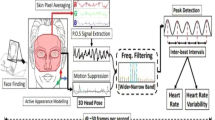Abstract
Remote monitoring with alerting systems becomes unavoidable in the field of remote healthcare. The efficiency of such a system depends on accuracy, easy-to-use, versatility, and cost-effectiveness. In this study, a remote cardiac health monitoring along with the alert raising facility is presented. Special design techniques have been adopted to craft the photoplethysmography (PPG) sensor to overcome the congenital limitations like pressure disturbance, the influence of ambient light and motion artifacts. Three key components like pulse rate (PR), blood pressure (BP) and heart rate variability (HRV) are considered to monitor the cardiac health status. A novel algorithm has been developed to detect the cardiac health status of any subject from the above-mentioned physiological parameters. Also, the variation of human skin tone across demography is considered to minimize the impact of skin structure variability in PPG-based cardiac parameter measurement. Decentralized remote monitoring architecture is implemented using the virtual network computing (VNC) platform. We conducted a trial where the training dataset consisted of data from 70 volunteers and the trial dataset considered 20 new volunteers. The overall accuracy of cardiac health monitoring achieved is 98.5%. The experimental results demonstrate the good promise of reliable and efficient system architecture.





Similar content being viewed by others
REFERENCES
World Population Ageing 2015 (ST/ESA/SER.A/390), New York: United Nations, Department of Economic and Social Affairs, Population Division, 2015.
Handler, J., Perm. J., 2009, vol. 13, no. 3, pp. 51–54. https://doi.org/10.1111/jch.12009
La Iacona, S., Militello, C., Serbanati, L.D., Mastratisi, M.A., Ricci, F.L., and Gilardi, M.C., Proc. E-Health and Bioengineering Conference (EHB), Iasi, 2015. https://doi.org/10.1109/EHB.2015.7391370
Azimi, I., Rahmani, A.M., Liljeberg, P., and Tenhunen, H., J. Ambient Intell. Humanized Comput., 2016, p. 1. https://doi.org/10.1007/s12652-016-0387-y
Fortino, G. and Giampà, V., Proc. IEEE Int. Workshop on Medical Measurements and Applications, Ottawa, 2010. https://doi.org/10.1109/MEMEA.2010.5480201
SeungMin Lee, HyunSoon Shin, and ChanYoung Hahm, Proc. 18th Int. Conference on Advanced Communication Technology (ICACT), Pyeongchang, 2016, p. 556. https://doi.org/10.1109/icact.2016.7423470
Shafique, M., Med. Biol. Eng. Comput., 2012, vol. 50, no. 6, pp. 575–583. https://doi.org/10.1007/s11517-012-0910-z
Mukherjee, R., Ghosh, S., Gupta, B., and Chakravarty, T., Telemed. e-Health, 2018, vol. 24, no. 3, pp. 185–193. https://doi.org/10.1089/tmj.2017.0117
Castaneda, D., Esparza, A., Ghamari, M., Soltanpur, C., and Nazeran, H., Int. J. Biosens. Bioelectron., 2018, vol. 4, no. 4, p. 195. https://doi.org/10.15406/ijbsbe.2018.04.00125
Zhang, Z., IEEE Trans. Biomed. Eng., 2015, vol. 62, no. 8, p. 1902. https://doi.org/10.1109/TBME.2015.2406332
Yung-Hua Kao, Paul C.-P. Chao, Tse-Yi Tu, Keng-Yueh Chiang, and Chin-Long Wey, Proc. 2016 IEEE SENSORS, Orlando, FL, 2016, pp. 1–3. https://doi.org/10.1109/ICSENS.2016.7808775
Leeudomwong, T., Tayard Deesudchit, and Chinrungrueng, C., Eng. Appl. Sci. Res., 2018, vol. 45, no. 2, p. 147. https://doi.org/10.14456/easr.2018.13
VNC–How it Works. https://www.hep.phy.cam.ac.uk/ vnc_docs/howitworks.html. Accessed January 12, 2019.
Security and Compliance: Our Fundamental Security Principles. https://www.realvnc.com/en/connect/security/.
Mukherjee, R., Dubey, S., Gupta, B., and Chakravarty, T., Proc. 2nd Int. Conference on Advances in Electrical, Electronics, Information, Communication and Bio-Informatics (AEEICB), Chennai, 2016, p. 450. https://doi.org/10.1109/AEEICB.2016.7538329
Hestenes, K., Nielsen, K.P., Zhao, L., Stamnes, J.J., and Stamnes, K., Appl. Opt., 2007, vol. 46, no. 12, pp. 2333–2350. https://doi.org/10.1364/AO.46.002333
Mukherjee, R., Ghosh, S., Gupta, B., and Chakravarty, T., Proc. Global Wireless Summit (GWS),IEEE, Cape Town, 2017, p. 193. https://doi.org/10.1109/GWS.2017.8300493
SeungMin Lee, HyunSoon Shin, and ChanYoung Hahm, Proc. 18th Int. Conference on Advanced Communication Technology (ICACT), Pyeongchang, 2016, pp. 556–558. https://doi.org/10.1109/icact.2016.7423470
A Short Introduction to the Processing Software and Projects from the Community. https://processing.org/overview/.
Encinas, C., Ruiz, E., Cortez, J., and Espinoza, A., Proc. Wireless Telecommunications Symposium (WTS), Chicago, IL, 2017, pp. 1–7. https://doi.org/10.1109/WTS.2017.7943540
Ash, C., Town, G., Bjerring, P., and Webster, S., Photonics Lasers Med., 2015, vol. 4, no. 2, p. 177. https://doi.org/10.1515/plm-2013-0056
Mukherjee, R., Ghosh, S., Gupta, B., and Chakravarty, T., Telemed. e-Health, 2018, vol. 24, no. 10, pp. 803–810. https://doi.org/10.1089/tmj.2017.0257
Attarpour, A., Mahnam, A., Aminitabar, A., and Samani, H., Biomed. Signal Process. Control, 2019, vol. 49, p. 212. https://doi.org/10.1016/j.bspc.2018.12.006
Mousavia, S.S., Firouzmandb, M., Charmia, M., Hemmatia, M., Moghadamc, M., and Ghorbanid, Y., Biomed. Signal Process. Control, 2018, vol. 47, p. 196. https://doi.org/10.1016/j.bspc.2018.08.022
Yang, S., Zhang, Y., Siu-Yeung Cho, Morgan, S.P., Correia, R., and Wen, L., Proc. SPIE, 2018, vol. 10820, p. 1082036. https://doi.org/10.1117/12.2502315
Tse-Yi Tu and Paul C.-P. Chao, Microsyst. Technol., 2018, vol. 24, no. 11, p. 4539. https://doi.org/10.1007/s00542-018-3957-4
He, X., Goubran, R.A., and Liu, X.P., IEEE Trans. Instrum. Meas., 2014, vol. 63, no. 6, pp. 1431–1439. https://doi.org/10.1109/TIM.2014.2299524
Selvaraj, N., Jaryal, A., Santhosh, J., Deepak, K.K., and Anand, S., J. Med. Eng. Technol., 2008, vol. 32, no. 6, p. 479. https://doi.org/10.1080/03091900701781317
Chiung-Cheng Chuang, Jing-Jhao Ye, Wan-Chun Lin, Kuan-Ting Lee, and Yu-Ting Tai, J. Clin. Monit. Comput., 2015, vol. 29, no. 6, p. 801. https://doi.org/10.1007/s10877-015-9669-8
Anagha, S., Suyampulingam, A., and Ramachandran, K.I., Proc. IEEE Int. Conference on Inventive Research in Computing Applications (ICIRCA), Coimbatore, 2018, pp. 804–809. https://doi.org/10.1109/ICIRCA.2018.8597329
Luke, A., Shaji, S., and Unnikrishna Menon, K.A., Proc. IEEE International Conference on Advances in Computing, Communications and Informatics (ICACCI), Bangalore, 2018, pp. 624–630. https://doi.org/10.1109/ICACCI.2018.8554599
Zneid, B.A., Al-zidi, M., and Al-kharazi, T., Proc. IEEE Region 10 Symposium, Kuala Lumpur, 2014, pp. 248–253. https://doi.org/10.1109/TENCONSpring.2014.6863036
Rotariu, C., Pasarica, A., Costin, H., Adochiei, F., and Ciobotariu, R., Proc. E-Health and Bioengineering Conference (EHB), Iasi, 2011, pp. 1–4.
ACKNOWLEDGMENTS
Authors are grateful to “BIT Mesra, Ranchi, India” for providing the logistical support to conduct this research activity. Special thanks to all the volunteers participated in this research.
Author information
Authors and Affiliations
Corresponding authors
Ethics declarations
CONFLICT OF INTEREST
The authors declare that they have no conflict of interest. Authors are declaring that no competing financial interests exist.
ETHICAL APPROVAL
All procedures performed in studies involving human participants were in accordance with the ethical standards of the “Ethical Committee, BIT Mesra” and with the 1964 Helsinki declaration and its later amendments or comparable ethical standards. This article does not contain any studies with animals performed by any of the authors.
Rights and permissions
About this article
Cite this article
Mukherjee, R., Ghorai, S.K., Gupta, B. et al. Development of a Wearable Remote Cardiac Health Monitoring with Alerting System. Instrum Exp Tech 63, 273–283 (2020). https://doi.org/10.1134/S002044122002013X
Received:
Revised:
Accepted:
Published:
Issue Date:
DOI: https://doi.org/10.1134/S002044122002013X




